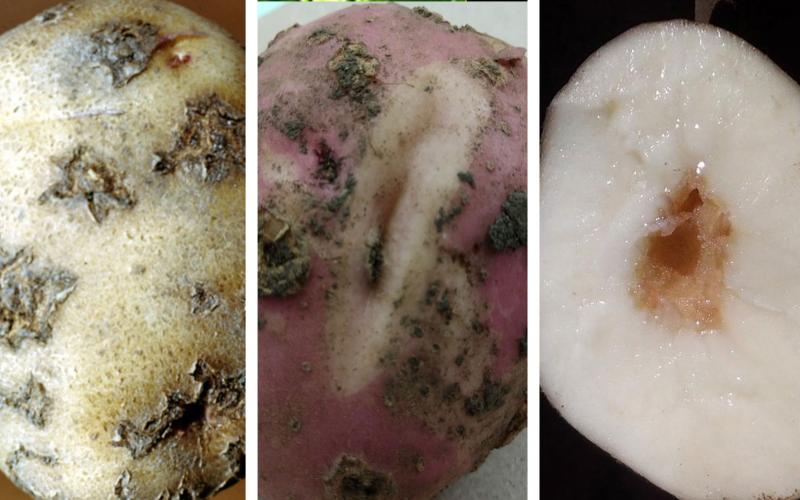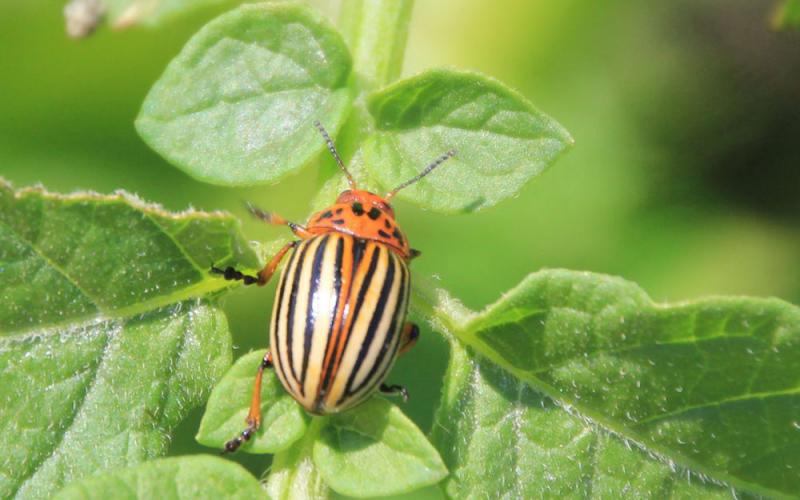Written by Rhoda Burrows, former Professor & SDSU Extension Horticulture Specialist.
Description

General Description: Potatoes have been grown as a food crop for over 6,000 years. They originate from the highlands of the Andes. Although they are frost-sensitive, they grow best in cooler temperatures. While potatoes are grown for their underground starchy tubers, they are closely related to tomatoes, peppers and eggplant. In fact, they sometimes form inedible above-ground fruit that looks very much like very small tomatoes.
Types: Potatoes are one of the world’s most-versatile vegetables. They can be boiled, baked or roasted, or used for fries or chips. Varieties are classified as starchy (best for baking) or waxy (best for boiling and in recipes, such as potato salad). Generally, the Russet types are best for baking, while Norland Reds are good for boiling. A number of varieties, such as Yukon Gold, can be used for either purpose.
Planting

Location: Potatoes thrive in well-drained loose soil. To decrease disease problems, select a location where potatoes or closely related crops (tomatoes, peppers or eggplant) have not been grown within the past three years. Also avoid planting where root crops, such as beets, carrots, radishes, parsnips, rutabagas or turnips were grown the previous year. In heavy soils, potatoes will benefit from being grown in a raised bed to allow for good soil drainage.
Planting: Potatoes are usually grown from overwintered tubers, although there is now one variety that can be planted from regular seed. The ‘eyes’ on the seed potato tuber are buds that will sprout into new plants. Small seed potatoes (golf-ball size) can be planted without cutting; larger ones should be cut into smaller pieces with at least 2 eyes per piece, minimizing the cut surface area as much as possible. Larger seed pieces will usually lead to more-vigorous plants at emergence. If possible, cut the seed potatoes 6 to 10 days before planting to allow a protective layer to form on the cut surfaces. After cutting, seed pieces should be stored at cool room temperatures at high humidity (90% or higher) but with good aeration to cut surfaces, to encourage the protective tissue to develop.
Seed potatoes should be planted 9-to-12 inches apart (depending on seed piece size) in a 3-to-4-inch deep trench with the eye side up and then covered with 2-to-3 inches of soil at planting. In heavy, poorly drained soils, plant more shallowly and pile soil over the tubers to create a raised bed. Alternatively, homeowners may use clean plastic straw to fill in the trench and then “hill” over the potatoes as they grow.
Other Growing Systems: Potatoes can be grown in a variety of systems as long as the developing tubers can be protected by adding additional soil, compost or straw as the plant grows:
- Traditional rows in the garden.
- Simply placing the seed tubers on top of the ground and covering with straw.
- Placed into straw bales.
- “Grow bags” of water-permeable plastic filled with potting soil.
- Garbage cans (provide drainage holes) or tires in which soil and/or straw is piled up.
The goal is to provide the plants with good conditions to form tubers, while making the eventual harvest of those tubers easier. Remember that the roots should be kept as cool as possible, so avoid (or paint) dark-colored containers. Keep in mind that if the potatoes are not grown in garden soil, they will need more complete nutrients added.

Timeline: Plant potatoes in the spring once soil temperatures reach 45°F but before soil temperatures are over 70°F consistently. Avoid late plantings, as the risk of tuber rot increases under hot summer temperatures.
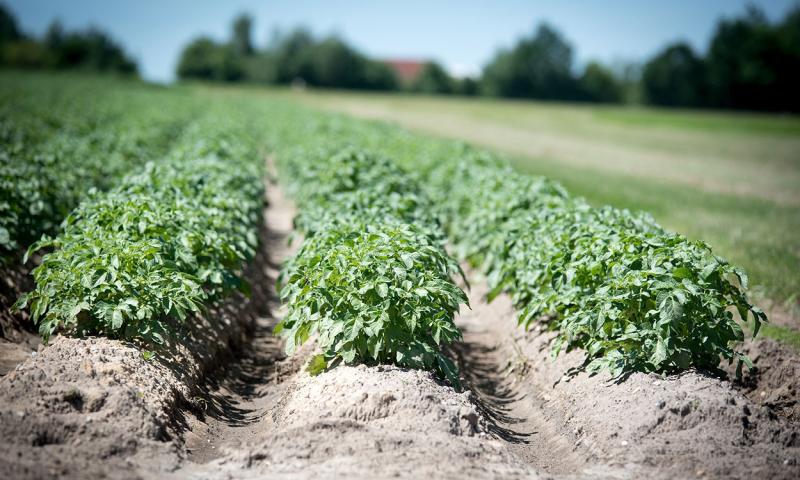
Hilling: Hilling (piling soil, straw or compost up around the base of the plant) should start when the plant is about 6 inches tall, and it can be completed by the time the plants bloom, ending with about 6 inches of total soil and/or mulch over the seed piece. This is done to cover and protect the developing tubers from exposure to light, which can cause the formation of toxic green tissue.
Watering: Allow the top inch or two of soil to dry down before watering thoroughly. Too much water early in the season can lead to rotting and even complete crop loss, while uneven moisture after the tubers begin to form (about the same time that the plants flower) can lead to knobby or hollow potatoes. Using mulch can help shade the soil and keep it cooler for good tuber formation.
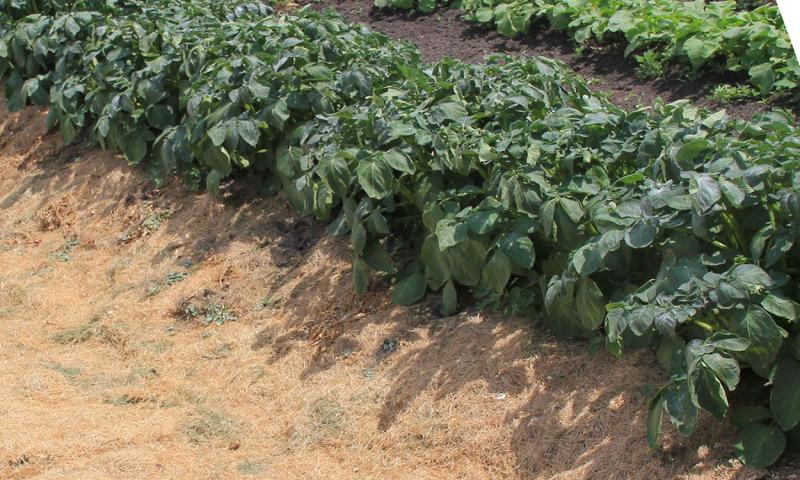
Fertilizing: About four weeks after planting, nitrogen fertilizer can be added to the soil as it is pulled up around the plant in the hilling process. Lawn fertilizers, such as 27-0-0- or 32-0-0, can work well to supply nitrogen (but make sure they DO NOT contain weed killer); apply about 1 cup per 50 feet of row, or about 3 tablespoons per 10 feet of row. Two weeks later, the process can be repeated.
Do not use manure as a fertilizer for potatoes grown in garden soil, as this encourages the disease potato scab.
Mulching: Light-colored straw mulch may decrease insect pests, such as aphids and thrips. More mulch may need to be added between rows if the mulch is used in hilling the potatoes.
Common Pests and Diseases
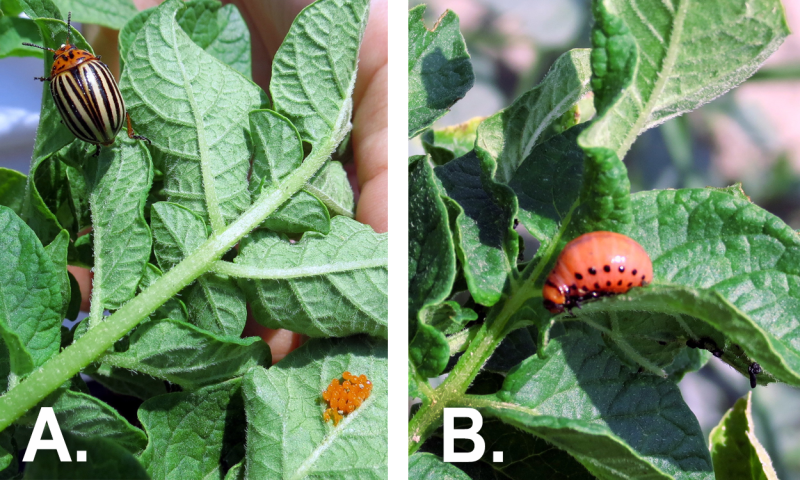
Pests
Colorado Potato Beetle: Colorado potato beetle adults emerge in the spring with females laying eggs in batches of up to two dozen on the undersides of leaves (Figure 6-A). A female has the potential to lay 500 or more eggs over a four-to-five-week period. An adult beetle has black and yellow/tan stripes. The larvae are bright red with black heads when they hatch but later change color to pink (Figure 6-B). The feeding of the beetle cause large holes on plant leaves and stripping of both leaves and shoots.
Reduce Colorado potato beetle by planting early and keeping the garden free of debris. It is important to control beetle damage especially once the plant begins to flower, because the leaves are needed then to contribute to the developing tubers. Handpick beetles off of plants and crush any yellow eggs on the undersides of the leaves. Most insecticides will not work on potato beetles, as they have developed resistance to them. Neem (for smaller larvae) and Spinosad (for larvae and adults) are two natural products that may provide some control. Always read and follow pesticide product label instructions.
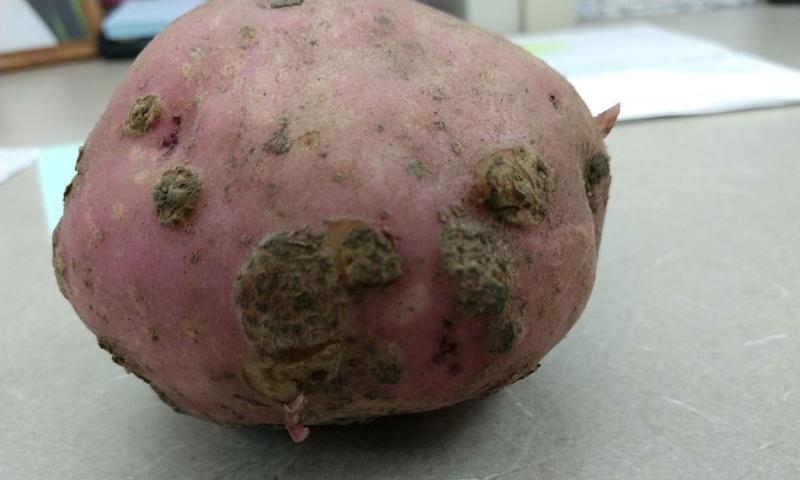
Diseases
Diseases affecting potato in home gardens may be seed-borne, soil-borne or acquired during the growing season. To reduce diseases, purchase certified seed potatoes and immediately remove any plants that are small, yellowing or appear diseased. The following are two of the most-common diseases seen in home gardens in South Dakota.
Common Scab: Caused by soil-borne bacterium Streptomyces scabies and most severe during warm and dry conditions. The disease symptoms are raised brown lesions on tubers with corky texture and deep, pitted brown or black lesions on tuber (Figure 7). The potatoes are still edible - the scabby areas can be peeled away.
Keep the soil evenly moist during the two months after planting and avoid applications of manure. Choose resistant cultivars, such as Caribe, LaRouge, Dark Red Norling, Rose Finn, Russett Nugget, French Fingerling, Yellow Finn, and Purple Viking. Avoid scab-susceptible varieties, such as Katahdin, Kennebec, Red Pontiac or Yukon Gold.
Verticillium Wilt: Caused by two closely-related soil-borne fungi. The disease is favored by moist soils and temperatures above 68°F. In home gardens, first signs of the disease are wilting on warm-sunny days, yellowing of lower leaves and curling leaves.
Prevention is the best way to control Verticillium wilt of potato. Avoid overwatering. Choose resistant varieties, such as Premier Russett, Ranger Russett, Gold Rush, Yampa, Red Beauty, Dakota Trailblazer, or Katahdin. Avoid susceptible cultivars, such as Russett Burbank, Red LaSoda, Superior, and Kennebec.
Harvest Tips
Harvest: Potato tubers reach maturity about two-to-three weeks after the plants have bloomed, or seven-to-eight weeks after planting, depending on the variety. New potatoes can be dug for immediate use as soon as they are large enough. For long-term storage, tubers should be harvested two-to-three weeks after the vines have died, which will allow the skin to harden. Vines can be killed by mowing them off or spraying them with a desiccant designed for that purpose. Growers can also wait to harvest until after a killing frost, but only if the soil temperatures stay above freezing for a week or two afterwards.
Harvest by gently digging with a fork, being careful to insert the fork far enough away from the plant to avoid spearing tubers in the process. If you damage some tubers, don’t attempt to store them – use them over the next few days. To prevent storage rots and sprouting, tubers should not be washed prior to storing, unless they are extremely muddy. If so, very gently wash and then air dry them (moist is ok, but not wet) prior to storage.
If the skins have not already hardened, allow the dug tubers to cure by storing them in a dark, but well-ventilated area at cool room temperatures (60 to 68 degrees Fahrenheit is ideal) for a few days to two weeks. The skins should then be “set” – that is, difficult to rub off with your finger.
Average Yield: 2 to 5 pounds per plant, or 10 to 20 pounds per 10 feet of row.
Storage, Cooking and Nutrition
Storage: Once cured, the potato tubers will keep best stored at 40 to 50 degrees Fahrenheit in relatively high humidity. If you don’t have an area that can be kept at that those temperatures, place the potatoes in the coolest area of the house, for example, a basement corner may stay cooler. However, do not refrigerate potatoes, as they will convert their starch to sugar.
Potatoes should always be kept in a dark area, or they will turn green and develop toxins. Do not store potatoes near apples or tomatoes, as ethylene given off by them may cause the potatoes to sprout. To prevent storage rots and sprouting, don’t store in closed plastic containers – allow some air movement.
Cooking: Potatoes are usually cooked by boiling, baking, microwaving, mashing, frying, grilling, or roasting. For recipes and more information, view our Pick it! Try it! Like it! resource for potatoes.
Nutrition Facts: A medium potato (unpeeled) can supply about 25% of the recommended daily amount for potassium, 70% of the recommended amount of Vitamin C, and 30% of the recommended amount for Vitamin B6 – all for between 110 and 150 calories.
Warning: Do not eat areas of the potato tuber that have turned green, as they can contain poisonous compounds – cut them out before cooking. Most of these compounds will be in the peel, so if in doubt, peel the whole potato as well as removing the green areas before cooking. If large areas are green, or if there is a bitter taste, do not eat that potato.
